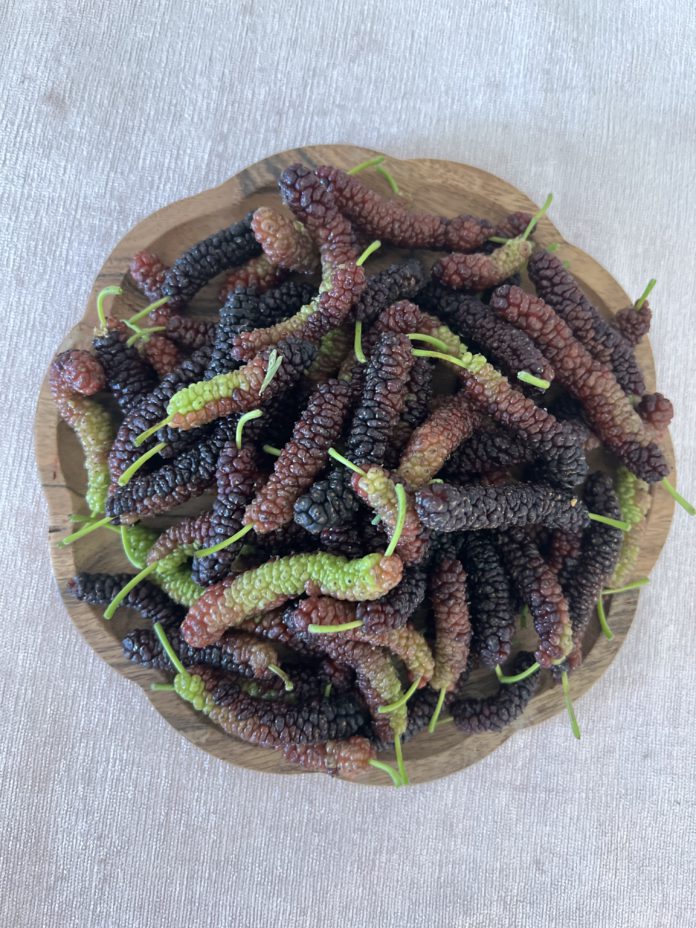The street vendor on his four-wheel cart, thela, announcing his arrival in a loud voice, brought a pile of soft bodied fruits. Some of them were green, some burgundy and others had hints of both. Even though it was expensive, my grandma believed in the value of the short-lived seasonal fruit and always bought it. I am sure she knew the medicinal benefits too. Sitting with her on a cot, I ate this fruit called shahtoot, or mulberry. When mom wore her silk saree, she mentioned how silkworms feed exclusively on the leaves of its tree to go through their life cycle. A few years ago I was in need of a fast-growing tree to create shade in my backyard, and the quest prompted the idea of planting the mulberry tree. With the Pakistan mulberry tree in my backyard, I could not be happier—When I pick the fruit, nostalgia blows through the leaves.
Mulberry growing
I purchased the tree from a local nursery, with the tag “Pakistan Mulberry (Morus alba x rubra)” and planted it during spring. While it did come with a very heavy price tag, what can a gardener do? The nursery told us not to amend the soil too much and let it grow in native soil. They also suggested giving it frost protection the coming winter, but the two-ft tree had already grown to 10 feet by the end of the year. The next year, it bore fruit, and since then it has been doing so every spring to summer.
The fruit is dark ruby to burgundy and is sweet and tart. It can reach up to five inches when ripe and can be enjoyed at varying stages of ripeness. The tree is self-fertile and does not need a pollinizer. Some people report they have successfully kept the tree in a container and harvested fruit, but I do not have any personal experience with that.
I have learned a few things in the process of growing and nurturing this tree. It is indeed a very fast-growing tree and inspires awe whenever I see it. The leaves are big and lush, making it a very dense tree as well. If the soil is too crumbly around it, or if the tree is watered too much, it has the potential to fall over even in light winds. If you do not want mulberry trees to become huge, then keeping them pruned is a must. I have been pruning mine every winter once it has dropped its leaves.
Harvesting and storing
Harvesting the fruit is pure joy. A fun way to harvest is by spreading a clean tarp or sheet under the tree and gently shaking the branches. The ripe fruit will fall right onto the tarp. One can pick individual fruits from the tree as well. However, if I do not keep the tree pruned through the years, the sheer size and the amount of fruit would become overwhelming. I also experience birds getting to the fruit way earlier in the morning than I do. Hanging bird tape on the tree has been helpful in fending them off.
The fruit can bruise easily, ripens fast and does not last more than a few days. Acting fast is the key to a successful harvest. Not only must one pick it fast, one must then use it fast as well. It is probably because of the fruit’s short shelf that we don’t find it in stores. After picking, I give mulberries a quick and gentle rinse and pat them dry on a towel, trying to finish up in a day or so. I save the extra harvest by making fruit spreads, or freezing. To freeze, rinse mulberries under cold water. Pat dry on a towel and lay them on a parchment lined tray. Once they have hardened, collect berries to be saved in a bag or a container in the freezer.
Mulberry spread

Pick a mix of sweet and tart fruit. Deep burgundy ones are very sweet, and the ones with hints of green are a bit tart. Select another fruit such as plum or even strawberries to give just a bit of body to the spread. Mulberries have a central stem and if you like to remove the stem when making the spread, please check out a video online. I do not remove the stem and roughly chop the fruit up before making the spread. Cook the roughly chopped up fruit in a heavy bottom pan on low heat, making sure it does not burn. As soon as the fruit has released juices, add sugar and cook until the sugar has completely dissolved. Adjust sugar based on sweetness preference, total amount of harvested fruit, and tartness levels. Store the spread in the refrigerator in a glass container. We enjoy it on a breakfast toast with a hot cup of coffee, or over a scoop of ice-cream among chit-chat and laughter.
Note: This article gives an overview of growing plants, sun and soil requirements, moisture needs etc. Plant health and growth will vary based on various factors. This article is intended for gardening and culinary inspiration only. Please consult your healthcare provider should you have any questions or concerns about adding any new foods or ingredients to your diet.




